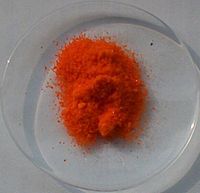Ceric ammonium nitrate
 |
|
| Names | |
|---|---|
|
IUPAC name
Diammonium cerium(IV) nitrate
|
|
| Other names
Ceric ammonium nitrate (CAN)
|
|
| Identifiers | |
| 16774-21-3 | |
| 3D model (Jmol) | Interactive image |
| ChemSpider | 157072 |
| ECHA InfoCard | 100.037.100 |
| EC Number | 240-827-6 |
| PubChem | 180504 |
|
|
|
|
| Properties | |
| H8N8CeO18 | |
| Molar mass | 548.26 g/mol |
| Appearance | orange-red crystals |
| Melting point | 107 to 108 °C (225 to 226 °F; 380 to 381 K) |
| 141 g/100 mL (25 °C) 227 g/100 mL (80 °C) |
|
| Structure | |
| Monoclinic | |
| Icosahedral | |
| Hazards | |
| GHS pictograms |
 
|
| GHS signal word | Danger |
| H272, H302, H315, H319, H335 | |
| P220, P261, P305+351+338 | |
|
EU classification (DSD)
|
|
| R-phrases | R8, R22, R36/37/38 |
| S-phrases | S17, S26, S36 |
| Related compounds | |
|
Related compounds
|
Ammonium nitrate Cerium(IV) oxide |
|
Except where otherwise noted, data are given for materials in their standard state (at 25 °C [77 °F], 100 kPa).
|
|
| Infobox references | |
Ceric ammonium nitrate (CAN) is the inorganic compound with the formula (NH4)2Ce(NO3)6. This orange-red, water-soluble cerium salt is a specialised oxidizing agent in organic synthesis and a standard oxidant in quantitative analysis.
The anion [Ce(NO
3)
6]2−
is generated by dissolving Ce
2O
3 in hot concentrated HNO3.
The salt consists of the anion [Ce(NO
3)
6]2−
and a pair of NH4+ counter ions. The ammonium ions are not involved in the oxidising reactions of this salt. In the anion each nitrate group is chelated to the cerium atom in a bidentate manner as shown below:
The anion [Ce(NO
3)
6]2−
has Th (idealized Oh) molecular symmetry. The CeO12 core defines an icosahedron.
...
Wikipedia
